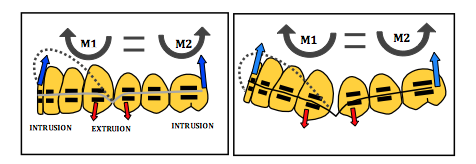The V-Bend intrusion mechanics had been known in literature, long time ago. Bendistal and Omni Pliers only could insert V-bend in super elastic wires and employed their light and consistent forces to simplify teeth intrusion for the first time. The mechanical force system resulting from the V-Bend in maxillary archwires, consists of two equal and opposite moments acting on teeth segments located in both sides of the bend. These moments intrude distant teeth, and extrude closer teeth to the bend. The same opposite disengaging effects of the inverted V-Bend in mandibular archwire, will result in a double disengaging effects. These effects facilitates mandibular incisors retraction which helps correct class III malocclusions without surgery; and disengages blocked cusps of posterior teeth that corrects crossbites without obstacle and without the hardship of the palatal expanders approach. Orthodontist can by inserting intraoral V-Bends squeezes of Bendistal or Omni Pliers, they can turns regular NiTi into an effective appliances that deliver mechanics on the buccal, rather than, palatal sides of teeth, all done during the patient’s regular adjustment visits..
 A, Shows the mechanics of V-bends. Note the long spring-back range made possible by placing the permanent V-Bend on super elastic maxillary archwire (dotted line). The equal and opposite intrusive forces and moments created by V-bends favorably intrude and disengage the furthest anterior and posterior teeth distal to the bends, and extrude the canines and premolar teeth closest to the bends, as side effect. Both the effects and side effects of this force system work favorably towards teeth disengagement, which positively enhance correcting crossbite and class III corrections. Note also how far the archwire is taken down to be tied into incisors brackets without deformation or loss of consistence. B, Shows the intrusion and extrusion effects that disengage teeth.
A, Shows the mechanics of V-bends. Note the long spring-back range made possible by placing the permanent V-Bend on super elastic maxillary archwire (dotted line). The equal and opposite intrusive forces and moments created by V-bends favorably intrude and disengage the furthest anterior and posterior teeth distal to the bends, and extrude the canines and premolar teeth closest to the bends, as side effect. Both the effects and side effects of this force system work favorably towards teeth disengagement, which positively enhance correcting crossbite and class III corrections. Note also how far the archwire is taken down to be tied into incisors brackets without deformation or loss of consistence. B, Shows the intrusion and extrusion effects that disengage teeth.

A: illustrates mandibular dental arches after alignment, with the preformed NiTi archwire (in black) tied in place. The blue colored line shows the shape of the wires after receiving the permanent inverted V-bend behind the canines. B: Shows the activated tied in NiTi archwire (in light green) being tied after it intrudes the most distant anterior and posterior teeth. C: Shows the mechanical effects on mandibular dental arch before and after illustrations superimposed

Leave A Comment